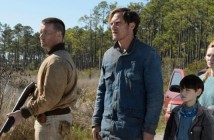
Editor’s Notes: Finding Dory is open in wide theatrical release today, June 17th.
Sequels. Sequels everywhere. Sequels last week. Sequels next week. Sequels every weekend through the end of summer and beyond. Thankfully, though, not all sequels are alike or made the same, especially where Pixar Animation Studios is concerned. Long the gold standard when it comes to family-oriented animated films, Pixar’s track record remains the envy of animated studios in and out of the United States. The occasional stumble – the less said about Cars 2, the better – has done little to tarnish Pixar’s reputation. Finding Dory, the thirteen-years-in-the-making sequel to Finding Nemo, a fish-in-water family tale that stirred the hearts and minds of moviegoers to rarely match box-office and artistic success, will do little, if anything, to change Pixar’s well-earned reputation as a studio dedicated to pushing the boundaries of the animated form while delivering the kind of sophisticated, nuanced storytelling that’s become synonymous with the Pixar name.
. . . while delivering the kind of sophisticated, nuanced storytelling that’s become synonymous with the Pixar name.

When we meet Dory (voiced Ellen DeGeneres) again, she’s still the Dory we remember: She still suffers from short-term memory loss (putting the “special” in “special needs”), but she’s also found a home with Marlin (Albert Brooks) and his son, Nemo (Hayden Rolence), the same Nemo who became the focal point of Marlin and Dory’s desperate, frantic search more than a decade ago. In Finding Dory, however, only a year’s time has passed and while Marlin, Nemo, and Dory are more or less happy living together as a family, she still pines wistfully for the parents she knows she had long ago, but can’t remember. An unexpected event, however, triggers a long dormant memory in Dory of the family she lost. (Fair warning: the flashback scenes have been engineered to induce maximum tear duct drainage.) She finally remembers where she came from and where her family might be found: The Marine Life Institute in California (or more generally, “the jewel of Morro Bay, California”).
Finding Dory doesn’t fall into the “lesser effort” category, however. While it certainly trades on the nostalgia for Finding Nemo . . .
Despite the distance between the Australian coral reefs and the California coast, Marlin, Nemo, and Dory call home, they head out on another life-changing adventure. But for Dory, it’s not the journey, but the destination that counts. Returning director Andrew Stanton (John Carter, Wall-E) spends almost no time traversing the wide ocean gulf between Australia and California. Minus a cameo by a certain stoner turtle that rides the ocean currents like surfers ride the ocean waves, Marlin, Nemo, and Dory make it to the Marine Life Institute with minimal incident. Almost immediately, however, human intervention separates the trio. Dory ends up in the quarantine section, becomes acquainted with a curmudgeonly, chameleon-like octopus, Hank (Ed O’Neill), and begins to discover the ins and outs, not to mention the various, varied different areas of the institute where her parents might be living. Hank doesn’t see Dory as a potential friend, just a way out. He doesn’t believe in the institute’s policy of “Rescue, Rehabilitation, and Release.” He wants to go to Cleveland and Dory’s orange tag will get him there.
Marlin and Nemo find themselves literally on the outside looking in. They’re outside the institute with no way in. Luckily, a couple of boisterous sea lions, Fluke (Idris Elba) and Rudder (Dominic West), step in to help. The Pixar universe might be filled with wonders and dangers – as an earlier meet-up with a squid suggests – but it’s also a fundamentally decent one, a universe where strangers help those in need of plot assistance find their way forward. While Marlin and Nemo inch closer to finding Dory, occasionally squabbling over Marlin’s unintentionally cruel, unkind treatment of Dory (short-term memory loss doesn’t mean her feelings can’t be hurt), Dory’s misadventures take center stage, giving Pixar’s animation team – once again pushing the digital envelope thanks to constantly evolving, in-house software – every opportunity to shine. And that’s exactly what they do: They shine. Everything from the characters, new and old, to the beautifully rendered, textured environments, and, of course, set piece animation, never fails to deliver on the awe and wonder typically of even Pixar’s lesser efforts.
Finding Dory doesn’t fall into the “lesser effort” category, however. While it certainly trades on the nostalgia for Finding Nemo and in Dory’s search for her long-lost parents, lacks the urgency of its predecessor, Finding Dory has more than its share of positives that could go beyond Pixar’s animation team. Finding Dory’s screenplay strikes a deft balance between Dory’s permanent condition and conventional storytelling’s need for character change and character arcs. Dory doesn’t so much change as accept her short-term memory loss as part of who she is, as integral to her identity. Her act now, live in the moment behavior also provides Finding Dory with another key life lesson, though too much of a good thing (spontaneity) has its pitfalls too. Dory doesn’t find that balance within herself, but rather in the family she forms with Marlin and Nemo. Marlin balances Dory’s spontaneity with his predictability. Together, they make one of the most indelible onscreen couples – animated or live-action – in recent memory.
Dory doesn’t find that balance within herself, but rather in the family she forms with Marlin and Nemo. Marlin balances Dory’s spontaneity with his predictability. Together, they make one of the most indelible onscreen couples – animated or live-action – in recent memory.



